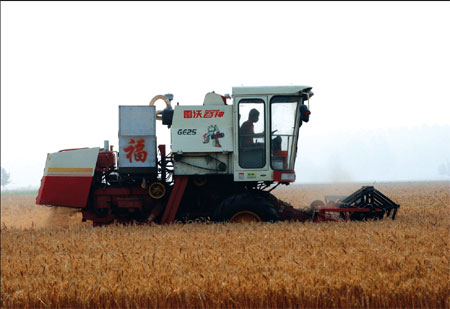|

A farmer in Shandong province uses a China-made combine to harvest wheat. Domestic manufacturers face stiff competition from state-of-the-art foreign machinery. Zhang Qingmin / for China Daily
|

Though it is now the world's largest producer of combine harvesters, China needs to greatly increase innovation capacity in the field, according to an annual report on agricultural machinery patents recently released by the State Intellectual Property Office.
"Technological progress in combines has a direct effect on yield, quality and costs of grain," Shang Yupei, head of the SIPO-sponsored program, told China Intellectual Property News.
The report shows that domestic patent applications for such machinery began a rapid surge in 2005, nearly three decades after Chinese farmers began using combines in the late 1970s.
SIPO has now received more than 3,000 patent filings on inventions related to combine harvesters. Five domestic companies and institutions were among the top 10 applicants.
One reason for the growth is that after absorbing the technology from overseas, Chinese agricultural machinery makers enhanced their R&D and adapted harvesters to specific production situations in the country, Shang said.
At the same time, an increasing number of patent applications from international giants in the industry put pressure on domestic manufacturers, spurring them to invest more on R&D, he added.
Domestic players have now captured some of the market at home and have begun to go abroad, said Cheng Cheng, a member of the research team.
'Golden period'
In addition to market demand, the development of domestic combine harvesters is closely related to national policies, Cheng said.
Favorable policies and increased mechanization of farm work have resulted in a "golden growth period" in the sector, Cheng said.
Data shows that 84 Chinese companies were involved in harvest machines over the past two years.
The annual output of crop harvesting machines, including combine harvesters, surpassed 1 million units in 2011, a rise of 50 percent over 2010.
Domestic demand for combines is estimated to reach 800,000 units between 2011 and 2015, an average of more than 150,000 of the massive machines each year, according to a development plan for agricultural machine industry formulated by the Ministry of Industry and Information Technology.
The enormous market potential has also brought a rise in patent filings by foreign companies.
Kubota Corp and Yanmar Co Ltd from Japan have each filed more than 70 patent applications in the country, while US agricultural machine giant John Deere has 17 filings.
Facing such dominant international players, the domestic industry still lags behind and faces a severe challenge in technological innovation, said Wang Guimin, board chairman of Foton Lovol International Heavy Industry Co Ltd. The company ranks third in Chinese patent applications related to combine harvesters.
Compared to machines produced in developed countries, the technologies in locally made combines are 20 to 30 years behind, said the ministry's report.
The difference is also reflected in patent filings. The bulk of domestic applications are for utility model patents, which are much easier to dispute than invention patents. Of the 80 applications by Foton Lovol, only nine are for invention patents.
Such heavy, complex agricultural machines generally require high capital investment and longer technological development, Cheng said, adding that major applicants are long-standing large agri-machine makers.
He also stressed that domestic manufactures have yet to increase their patent awareness.
They need to make full use of patent information as they continue on the path of innovation and develop proprietary products, Shang said.
Cheng suggested Chinese companies look for expired patents and select key technologies from global patent databases as a reference for the direction their innovation should take.
zhangzhao@chinadaily.com.cn
(China Daily 11/21/2012 page10)


